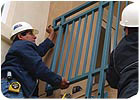From Architect to End User: Powder Coating Specifications
If an architectural finish fails, everyone involved in the project risks liability if clear specifications aren’t provided and followed. This article details the ins and outs of specifying powder coating finishes for building applications.

Finishing specifications for architectural applications should be simple, concise, complete, accurate and relevant to the intended use of the product. Unfortunately, many finishing specifications are vague and ambiguous, and they often do not offer enough detail for subcontractors to follow. Moving forward with incomplete or unclear specifications presents a significant liability concern for everyone involved in the project.
If the protective or decorative function of the coating fails, the failure mode will be analyzed by industrial finishing experts, metallurgists and processing professionals to determine the exact root cause. Following the discovery process, legal experts will analyze the information available to determine who is responsible and ultimately who will pay for the cost of remediation. In more than one case, the judicial ruling spread the financial responsibility over multiple companies due to a general failure by all parties to exercise due diligence during the planning and procurement stages of the project.
Wise contractors never begin work without a clear vision of the exact scope of work and a plan to accomplish the common goals set forth by the design team.
Typically, the specifications and standards for a given project are referenced in a single document authored by the design authority and must be followed in detail by the general contractor and all of the subcontractors. It is not uncommon to see language in the instructions from the architect or planner that any deviations, substitutions or changes to original design specification must be authorized in writing by the design authority.

In general, a performance specification communicates the user’s requirements to the finishing contractors and sometimes their suppliers. It translates operational requirements into more technical language that tells the manufacturer: 1) what the end user will consider an acceptable finished product, and 2) how the end user will determine whether the finish on the product is acceptable. To the extent that any specification does these two things, it is a good specification.
A performance specification should not include instructions on how to achieve the results - i.e., process specifications - unless absolutely necessary. If the specification tells the manufacturer or contractor specifically how to make and finish the product, the owner might miss out on an opportunity to obtain an improved, less costly, or more reliable product because the specification has constrained the ability of the contractors to be innovative. Worse, when planners are not sure about the best way to finish a product, communicate their knowledge and requirements poorly, or need finishing processes or materials that they might not know about, they might do serious harm by including “how to” information in the specification.
For example, if there is a chemical cleaning conversion coating process call-out on a processing specification for cold rolled steel and the metal is received with heavy corrosion or laser scale, a mechanical abrasion process might be necessary prior to the chemical cleaning and conversion coating to achieve the desired performance characteristics that the product needs. Following the stated process specification without additional processing would result in a predictable catastrophic adhesion loss and corrosion failure. (Note: Metal finishing professionals wouldn’t allow this important detail to be overlooked. The proper protocol would be to provide a formal written request for a deviation from the specification and an add-on requirement for the abrasive cleaning process due to this unforeseen condition of the metal.)
While some process specifications might be required, even the most talented architects cannot possibly predict all of the potential conditions and variables that might lead to a premature failure of the finish. Performance specifications should leave out unnecessary process information and give the finishing contractor the latitude to determine how best to meet the stated needs.
A needs analysis should precede every part of the design, planning and finishing stages of projects that require service life warranties. In fact, service life warranties are always conditional, and the language of such warranties often limit the liability of suppliers, define predictable and expected changes by quantifiable means, and offer no guarantees due to the uncontrollable effect of the various conditions that “cause” or “contribute to the cause” of coating failures. Issues such as protective packaging during transportation and installation, hardware to prevent dissimilar metal corrosion, touchup methods for damaged areas and customer care and maintenance details are all important factors to consider. This pragmatic approach during the needs analysis can be used to understand the technologies involved, the alternatives available, and the feasibility of meeting the requirements of the end user, as well as to assist the estimator in establishing the cost.
The entire set of documents that make up the contract serve as the roadmap for the activities and processes that are to be accomplished. Contract documents include the form of agreement, the conditions of the contract, specifications, drawings, warranties and other important details. They also include addenda issued during bidding and contract modifications, such as change orders, construction change directives, and others issues that might have to be addressed after execution of the initial contract.
For more information about powder coatings, visit www.ikonpowdercoating.com.

This case and dozens of others like it demonstrate the importance of developing and following a solid plan to ensure quality and value.

The powder coatings on this jobsite, located 200 yards from the ocean in Southern California, experienced premature adhesion and corrosion failure within two years because the contractor deviated from the specification and used a substitute metal and finishing process.
Finishing specifications for architectural applications should be simple, concise, complete, accurate and relevant to the intended use of the product. Unfortunately, many finishing specifications are vague and ambiguous, and they often do not offer enough detail for subcontractors to follow. Moving forward with incomplete or unclear specifications presents a significant liability concern for everyone involved in the project.
If the protective or decorative function of the coating fails, the failure mode will be analyzed by industrial finishing experts, metallurgists and processing professionals to determine the exact root cause. Following the discovery process, legal experts will analyze the information available to determine who is responsible and ultimately who will pay for the cost of remediation. In more than one case, the judicial ruling spread the financial responsibility over multiple companies due to a general failure by all parties to exercise due diligence during the planning and procurement stages of the project.
Wise contractors never begin work without a clear vision of the exact scope of work and a plan to accomplish the common goals set forth by the design team.
The Project Specification
The architect generally works closely with the building owner to design a facility that meets the needs of the occupants, including any special requirements that might be associated with the surrounding environment. The project specification creates a project plan or mapping diagram as to how the project will be constructed and finished. Specifications generally are defined as standards of practice that are proven to be effective and necessary for quality assurance. While architects and planners rely on nationally recognized standards established by the American Architectural Manufacturers Association (AAMA), Qualicoat, SSPC: The Society of Protective Coatings, ASTM International (originally the American Society for Testing and Materials) and other organizations when creating a project specification, there are no “cookie cutter” templates or examples that apply to every project.Typically, the specifications and standards for a given project are referenced in a single document authored by the design authority and must be followed in detail by the general contractor and all of the subcontractors. It is not uncommon to see language in the instructions from the architect or planner that any deviations, substitutions or changes to original design specification must be authorized in writing by the design authority.

Using the correct materials and finishing processes to meet the performance specification established by the architect/specifier can help contractors ensure a long-lasting finish.
Performance vs. Process Specifications
A performance specification focuses on the quality attributes of the final finish. The end result of the finish is specified, rather than the way to achieve the end result. An example of this type of specification is found in documents published by the American Architectural Manufacturers Association (AAMA). These documents represent the voluntary performance criteria for the application of an organic coating on aluminum extrusions and panels (AAMA2603, AAMA 2604, AAMA 2605). (It must be understood that AAMA documentation only refers to aluminum substrates, and in building construction there exist a multitude of metals, including steel, galvanized steel, stainless steel, metalized steel, and a host of other metal types, that might require special preparation or processing or unique finishing materials.)In general, a performance specification communicates the user’s requirements to the finishing contractors and sometimes their suppliers. It translates operational requirements into more technical language that tells the manufacturer: 1) what the end user will consider an acceptable finished product, and 2) how the end user will determine whether the finish on the product is acceptable. To the extent that any specification does these two things, it is a good specification.
A performance specification should not include instructions on how to achieve the results - i.e., process specifications - unless absolutely necessary. If the specification tells the manufacturer or contractor specifically how to make and finish the product, the owner might miss out on an opportunity to obtain an improved, less costly, or more reliable product because the specification has constrained the ability of the contractors to be innovative. Worse, when planners are not sure about the best way to finish a product, communicate their knowledge and requirements poorly, or need finishing processes or materials that they might not know about, they might do serious harm by including “how to” information in the specification.
For example, if there is a chemical cleaning conversion coating process call-out on a processing specification for cold rolled steel and the metal is received with heavy corrosion or laser scale, a mechanical abrasion process might be necessary prior to the chemical cleaning and conversion coating to achieve the desired performance characteristics that the product needs. Following the stated process specification without additional processing would result in a predictable catastrophic adhesion loss and corrosion failure. (Note: Metal finishing professionals wouldn’t allow this important detail to be overlooked. The proper protocol would be to provide a formal written request for a deviation from the specification and an add-on requirement for the abrasive cleaning process due to this unforeseen condition of the metal.)
While some process specifications might be required, even the most talented architects cannot possibly predict all of the potential conditions and variables that might lead to a premature failure of the finish. Performance specifications should leave out unnecessary process information and give the finishing contractor the latitude to determine how best to meet the stated needs.
Reference Standards: A Note of Caution
To eliminate writing lengthy descriptions, planners and architects usually reference nationally recognized standards. However, such standards are developed by consensus and usually set minimum requirements that might not be sufficient to meet the needs of special projects. Poor standards exist with good standards, and most standards include hidden choices that must be made and included in the citation within the specification. Such choices include different grades, types and classes that allow for various levels of quality and alternative or optional attributes. Additionally, reference standards are constantly updated, withdrawn, or replaced by other standards. Relying on citations in previous project specifications without current knowledge of the cited standard can result in inaccurate, incorrect or obsolete references.Needs Analysis Before Warranty Demands
To write effective performance requirements, architects and planners must understand the end user’s actual needs and the technical characteristics of the products that might meet those needs. The best way to achieve both of these ends is through an analysis of the user’s needs. The design and specification of the proper “engineered finishing system” must match the service life intent of the product within a predictable corrosive environment. A complete analysis examines all of the available details that influence the service life of the finish and end use product. For example, powder coated interior stairwells in an air-conditioned environment are far less likely to corrode than handrails and guardrails subject to open exposure to the ocean. Suppliers should provide documentation to identify existing technology that will fulfill the decorative and protective requirements of these various needs.A needs analysis should precede every part of the design, planning and finishing stages of projects that require service life warranties. In fact, service life warranties are always conditional, and the language of such warranties often limit the liability of suppliers, define predictable and expected changes by quantifiable means, and offer no guarantees due to the uncontrollable effect of the various conditions that “cause” or “contribute to the cause” of coating failures. Issues such as protective packaging during transportation and installation, hardware to prevent dissimilar metal corrosion, touchup methods for damaged areas and customer care and maintenance details are all important factors to consider. This pragmatic approach during the needs analysis can be used to understand the technologies involved, the alternatives available, and the feasibility of meeting the requirements of the end user, as well as to assist the estimator in establishing the cost.
Conditions of the Contract
General conditions are usually standard documents that apply to any project. Supplementary or special conditions modify the general conditions to make them project-specific. These documents set the rights, responsibilities, and relationships for the involved parties. In addition to the agreement, the conditions of the contract(s) set the requirements for the contractor(s) to provide materials, workers, tools, equipment, insurance and warranties to perform the work as described in the rest of the planning documents. The conditions also set the requirements for the owner and the architect and engineer to perform certain tasks during construction (such as reviewing submittals and applications for payment or progress payments).The entire set of documents that make up the contract serve as the roadmap for the activities and processes that are to be accomplished. Contract documents include the form of agreement, the conditions of the contract, specifications, drawings, warranties and other important details. They also include addenda issued during bidding and contract modifications, such as change orders, construction change directives, and others issues that might have to be addressed after execution of the initial contract.
A Durable Finish
Creating an effective project specification requires the collaboration of everyone involved, from the building owner/developer, architect/specifier and general contractor, to the fabricator/installation contractor, finish contractor, and pretreatment and material supplier(s). If problems arise on the jobsite, it is the responsibility of the contractors to work with the architect/specifier and building owners to resolve these issues, formally requesting deviations from the specification if necessary. By following a clear, complete specification and using products and processes that meet the stated objectives, contractors can minimize their liability and ensure a long-lasting, high-quality finish.For more information about powder coatings, visit www.ikonpowdercoating.com.

The powder coatings on these aluminum extrusions failed due to an improper surface pretreatment and an inferior coating selection for the intended use of the product.
SIDEBAR: The Cost of Noncompliance
When the powder coatings on a resort hotel near the ocean in Southern California failed within two years, everyone involved in the project blamed everyone else. A legal battle ensued. The building owner demanded $2.4 million to cover the cost of remediation, including removing the defective product, fabricating new railings and finishing them according to the original specification. The case was in the court system for almost eight years before being settled by the insurance companies for $1 million. The determination of fault and responsibility (achieved by agreement in mediation settlement hearings with the insurance companies’ legal counsel) was spread between the general contractor (30%), the fabricator (30%), the powder coating contractor (30%), and the powder coating supplier (10%). Many factors were at fault, ranging from the specific language of the specification to undocumented deviations in processes and materials. The legal fees incurred by the collective parties exceeded the million dollar settlement amount by more than double.This case and dozens of others like it demonstrate the importance of developing and following a solid plan to ensure quality and value.
Looking for a reprint of this article?
From high-res PDFs to custom plaques, order your copy today!







